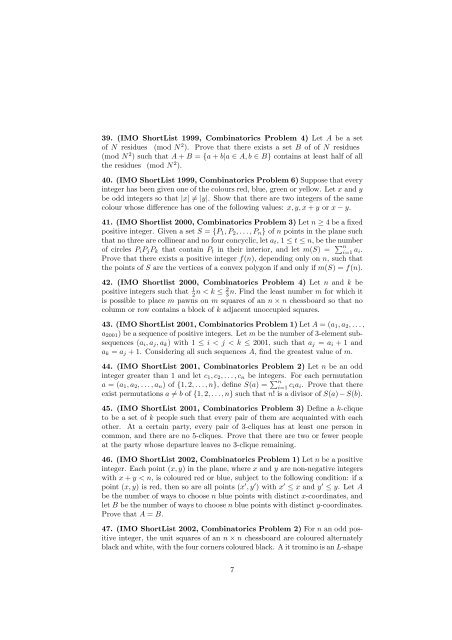Combinatorics Problems
Combinatorics Problems
Combinatorics Problems
Create successful ePaper yourself
Turn your PDF publications into a flip-book with our unique Google optimized e-Paper software.
39. (IMO ShortList 1999, <strong>Combinatorics</strong> Problem 4) Let A be a set<br />
of N residues (mod N 2 ). Prove that there exists a set B of of N residues<br />
(mod N 2 ) such that A + B = {a + b|a ∈ A, b ∈ B} contains at least half of all<br />
the residues (mod N 2 ).<br />
40. (IMO ShortList 1999, <strong>Combinatorics</strong> Problem 6) Suppose that every<br />
integer has been given one of the colours red, blue, green or yellow. Let x and y<br />
be odd integers so that |x| ≠ |y|. Show that there are two integers of the same<br />
colour whose difference has one of the following values: x, y, x + y or x − y.<br />
41. (IMO Shortlist 2000, <strong>Combinatorics</strong> Problem 3) Let n ≥ 4 be a fixed<br />
positive integer. Given a set S = {P 1 , P 2 , . . . , P n } of n points in the plane such<br />
that no three are collinear and no four concyclic, let a t , 1 ≤ t ≤ n, be the number<br />
of circles P i P j P k that contain P t in their interior, and let m(S) = ∑ n<br />
i=1 a i.<br />
Prove that there exists a positive integer f(n), depending only on n, such that<br />
the points of S are the vertices of a convex polygon if and only if m(S) = f(n).<br />
42. (IMO Shortlist 2000, <strong>Combinatorics</strong> Problem 4) Let n and k be<br />
positive integers such that 1 2 n < k ≤ 2 3n. Find the least number m for which it<br />
is possible to place m pawns on m squares of an n × n chessboard so that no<br />
column or row contains a block of k adjacent unoccupied squares.<br />
43. (IMO ShortList 2001, <strong>Combinatorics</strong> Problem 1) Let A = (a 1 , a 2 , . . . ,<br />
a 2001 ) be a sequence of positive integers. Let m be the number of 3-element subsequences<br />
(a i , a j , a k ) with 1 ≤ i < j < k ≤ 2001, such that a j = a i + 1 and<br />
a k = a j + 1. Considering all such sequences A, find the greatest value of m.<br />
44. (IMO ShortList 2001, <strong>Combinatorics</strong> Problem 2) Let n be an odd<br />
integer greater than 1 and let c 1 , c 2 , . . . , c n be integers. For each permutation<br />
a = (a 1 , a 2 , . . . , a n ) of {1, 2, . . ., n}, define S(a) = ∑ n<br />
i=1 c ia i . Prove that there<br />
exist permutations a ≠ b of {1, 2, . . ., n} such that n! is a divisor of S(a) −S(b).<br />
45. (IMO ShortList 2001, <strong>Combinatorics</strong> Problem 3) Define a k-clique<br />
to be a set of k people such that every pair of them are acquainted with each<br />
other. At a certain party, every pair of 3-cliques has at least one person in<br />
common, and there are no 5-cliques. Prove that there are two or fewer people<br />
at the party whose departure leaves no 3-clique remaining.<br />
46. (IMO ShortList 2002, <strong>Combinatorics</strong> Problem 1) Let n be a positive<br />
integer. Each point (x, y) in the plane, where x and y are non-negative integers<br />
with x + y < n, is coloured red or blue, subject to the following condition: if a<br />
point (x, y) is red, then so are all points (x ′ , y ′ ) with x ′ ≤ x and y ′ ≤ y. Let A<br />
be the number of ways to choose n blue points with distinct x-coordinates, and<br />
let B be the number of ways to choose n blue points with distinct y-coordinates.<br />
Prove that A = B.<br />
47. (IMO ShortList 2002, <strong>Combinatorics</strong> Problem 2) For n an odd positive<br />
integer, the unit squares of an n × n chessboard are coloured alternately<br />
black and white, with the four corners coloured black. A it tromino is an L-shape<br />
7
















